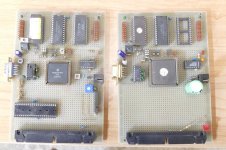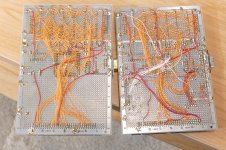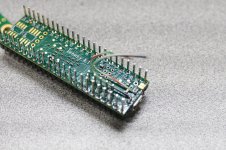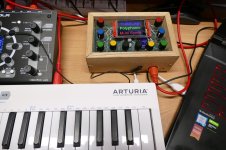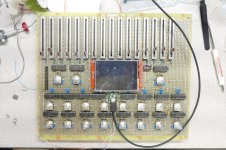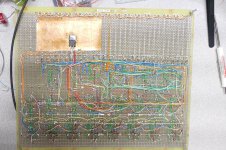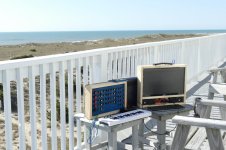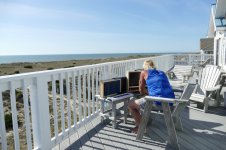A regular occurrence on another forum is that a new member walks in and asks "Which distro?" The distro wars ensue. It is like a parallel universe to asking about amplifiers on DIYAudio. 🙂
Ed
Ed
Same here in plain text file, plus make a copy onto your phone in case you don't have any other machine (with internet to look up for help) near you if boot up would fail and then would have to enter Grub boot menu and from there select "advanced options..." (from here one can run boot repair etc) to rectify and running cli commands if be needed.I have the command strings saved in a file
IMPORTANT!: To make sure Grub boot menu pops up at boot up you have to edit the following file:
/etc/default/grub.d/90_custom.cfg: (in my case it happens to be /etc/default/grub)
and add the following two lines ('5' is in seconds before the boot skips the menu and proceeds as normal)
Code:
GRUB_TIMEOUT="5"
GRUB_TIMEOUT_STYLE="menu"https://linuxmint-user-guide.readthedocs.io/en/latest/grub.html
When I install Linux I actually install a second Linux partition just in case..
Edit: btw when installing a 2nd Linux it will appear in that Grub menu.
Last edited:
Well, my main audio set up is paralleled multi amp'd. one preamp to two sets of amps to two sets of speakers.... sort of like the preamp is running asynchronous while the amps are synchronous. The speakers, ay! Talk about group delay... like measured in feet.
Distro wars.... I like that. Is that like a German Disco?
I still remember the late 90s when we didn't do distros... we built our own distro. Real Men built it themselves. Talk about religious Unix Crusades in Usenet. The Linux groups then were sort of an offshoot of the alt.evil group.
https://groups.google.com/g/news.groups/search?q=alt.evil&sortBy=DATE
BTW, my W11 is up and running again. I just got to remember to back up the Chrome configuration to the NAS more often. The email, via Thunderbird, is already set up for roaming.
I think I can count with the fingers of my left hand how many times I've had to reboot the Ubuntu In The Closet in the last 20 years. I got it behind a UPS so even if the power goes out, it has like 12 hours of standby power and it just, doesn't, break, ( I hope I didn't jinx it ).
W11.... I've had it Not Wake UP On Monday AM too many times in just three years.
Distro wars.... I like that. Is that like a German Disco?
I still remember the late 90s when we didn't do distros... we built our own distro. Real Men built it themselves. Talk about religious Unix Crusades in Usenet. The Linux groups then were sort of an offshoot of the alt.evil group.
https://groups.google.com/g/news.groups/search?q=alt.evil&sortBy=DATE
BTW, my W11 is up and running again. I just got to remember to back up the Chrome configuration to the NAS more often. The email, via Thunderbird, is already set up for roaming.
I think I can count with the fingers of my left hand how many times I've had to reboot the Ubuntu In The Closet in the last 20 years. I got it behind a UPS so even if the power goes out, it has like 12 hours of standby power and it just, doesn't, break, ( I hope I didn't jinx it ).
W11.... I've had it Not Wake UP On Monday AM too many times in just three years.
Last edited:
Well, that behavior certainly crosses my line in the sand. And that's what this thread is about - or what I'm not about to take on, an OS that I have no control over. Not that I have a lot of "control" over the Linux distro, but at least it does most of what I need without "control" of it being systematically removed for commercial gains.MIND YOU. I have modified the stupid registry so it would NOT do that... but the fu%%%r did it.... and shut itself down over night ( I don't turn off my machines ).
You sound like you have much more machine programming experience than I; if you cant spank that W11 OS into behaving as you wish, what of a more ordinary consumer? No hope. Apparently, M$ can just fly right past whatever "registry" settings instruct it to allow - If they can do that, then we are truly only "leasing" their system for a fee, be it one time or annual.
Thing is, my computers are like a mechanic's car.
I don't often read the manual.
Maybe there's something else in W11 that I ought to do? Right now, so long as the data is in the NAS and I got a standby W10 right next to it, all I got to do is press a switch on the KVM and I continue.
The work computer, provided to me by the client, is a very nice Dell i9 with Windows 10. Maybe that's a hint?
BTW, downloading things automatically for you also happens in Linux. I posted that earlier. I think it was CentOS... or maybe Mint. I forget. Although disabling it is just a matter of running a configuration script on the CLI.
Oh, I'm still running a copy of Office 2010 that I purchased through work eons ago. It allows for four concurrent users. By now I must have installed in in eight, or more, machines, as I upgrade. I definitely will not be leasing no stinking Office 365. That, to me, is a terrible marketing mistake by Microsoft.
My last two "laptops" are Chromebooks, which are easy to take on travel. I can browse, email, play music... pretty much 90% of what I do with a PC at home. I also download an "Office" like application. Mostly so I can read Word and Excel docs. It works fine, actually. But I don't like that is uses my Google username/password.
I don't often read the manual.
Maybe there's something else in W11 that I ought to do? Right now, so long as the data is in the NAS and I got a standby W10 right next to it, all I got to do is press a switch on the KVM and I continue.
The work computer, provided to me by the client, is a very nice Dell i9 with Windows 10. Maybe that's a hint?
BTW, downloading things automatically for you also happens in Linux. I posted that earlier. I think it was CentOS... or maybe Mint. I forget. Although disabling it is just a matter of running a configuration script on the CLI.
Oh, I'm still running a copy of Office 2010 that I purchased through work eons ago. It allows for four concurrent users. By now I must have installed in in eight, or more, machines, as I upgrade. I definitely will not be leasing no stinking Office 365. That, to me, is a terrible marketing mistake by Microsoft.
My last two "laptops" are Chromebooks, which are easy to take on travel. I can browse, email, play music... pretty much 90% of what I do with a PC at home. I also download an "Office" like application. Mostly so I can read Word and Excel docs. It works fine, actually. But I don't like that is uses my Google username/password.
Last edited:
Thanks for that, I'm pretty sure those lines are there as I get the boot selection for 5 seconds every power cycle.in case you don't have any other machine (with internet to look up for help)
Always been a bit of a junk man. Probably have about 10 other booting machines besides the phone in "reserve"...most on shelves. My "college kid" studying computer science only keeps his one laptop, sent the desktop home "dont need it". I find it stunning he'd rely on just one computer (besides phone) while taking on a college education. I've got 10 and I'm not even doing anything that important!!
To many of us, our computers are tools. Like a tool, we expect them to work, period. We shouldn't have to change stuff unless we need it to do something else. I'm in that boat.
I used to have to maintain my shops and all the users for networking. Gave up on Windows NT4 (eventually got it sort of working). OS/2 Server was reliable, pushed resources (so not running around to each workstation) and would survive power fails gracefully. NT4, possible reinstallation when that happened. I was running JFS file system when IBM introduced it. Wonderful.
I got pushed off Linux only because certain hardware needed Windows to run their app. Then that hardware became unusable when Microsoft made major changes. I am so dine with Microsoft. Win7 Pro worked fine. Win10 Pro, nightmare. From what I have heard in the field, Win11 is even worse.
I used to have to maintain my shops and all the users for networking. Gave up on Windows NT4 (eventually got it sort of working). OS/2 Server was reliable, pushed resources (so not running around to each workstation) and would survive power fails gracefully. NT4, possible reinstallation when that happened. I was running JFS file system when IBM introduced it. Wonderful.
I got pushed off Linux only because certain hardware needed Windows to run their app. Then that hardware became unusable when Microsoft made major changes. I am so dine with Microsoft. Win7 Pro worked fine. Win10 Pro, nightmare. From what I have heard in the field, Win11 is even worse.
W7 Pro, XP and NT4 were good. OS/2 was also quite good, I used to love that little dinosaur on the screen...
Win10 is OK.... Win11 is a PITA, they are trying to make a PC as if it were a mobile device... so now they got an "app store" and so on. The thing is that a PC is not a touch screen device and it's not really portable.
Linux is free so far as it doesn't create a real financial threat to Apple and Microsoft. One of these days, someone will decide to stop the DIY monkeying around and release a commercial Linux for 120 bucks. Then watch how the Big Guys react. As it is, I find Unix/Linux more comfortable to work in but the market has been moving towards Windows big time.... JTAG, debuggers, simulators, IDEs, etc... all run in Windows now. Few run in Linux because there is no standard Linux distribution to build to and no one making a commercial tool is gonna release the code and support it when the customers are running all kinds of different flavors of the OS.
What I find so funny is how often we install the MKS toolkit into Windows boxes... Just so we have a decent, CLI environment for Windows... grep, find. vi, ls, make, gcc, ds, du, and so on and on and on....
That's why I commented that Ubuntu is the Gold Standard that vendors support.
Win10 is OK.... Win11 is a PITA, they are trying to make a PC as if it were a mobile device... so now they got an "app store" and so on. The thing is that a PC is not a touch screen device and it's not really portable.
Linux is free so far as it doesn't create a real financial threat to Apple and Microsoft. One of these days, someone will decide to stop the DIY monkeying around and release a commercial Linux for 120 bucks. Then watch how the Big Guys react. As it is, I find Unix/Linux more comfortable to work in but the market has been moving towards Windows big time.... JTAG, debuggers, simulators, IDEs, etc... all run in Windows now. Few run in Linux because there is no standard Linux distribution to build to and no one making a commercial tool is gonna release the code and support it when the customers are running all kinds of different flavors of the OS.
What I find so funny is how often we install the MKS toolkit into Windows boxes... Just so we have a decent, CLI environment for Windows... grep, find. vi, ls, make, gcc, ds, du, and so on and on and on....
That's why I commented that Ubuntu is the Gold Standard that vendors support.
It is an option for Mint that is diabled by default.BTW, downloading things automatically for you also happens in Linux. I posted that earlier. I think it was CentOS... or maybe Mint. I forget.
I installed Mint for a friend. The last time I visited I checked the system, and an update had never been run since I installed Mint. So, I turned on auto update for them.
I have it set to download automatically, but only update when I command it to. Never had a problem.
Yeah, maybe it was Mint running on those machines in the lab. Killed the nightly regression tests, it sure did. More than a 100 machines. Kept the techs busy.
We deep rooted it pretty fast as some of us in the office were also running Mint in our development machines and our configuration was identical to the lab.
We deep rooted it pretty fast as some of us in the office were also running Mint in our development machines and our configuration was identical to the lab.
My first "computer" was a SWTPC MC6800 machine built from a kit in 1976. Next came a bunch of Apple II clones and the obligatory TRS-80. In 1981 or 1982 a friend shows up at my house with a car trunk full of stuff he dumpster dived from the IBM plant in Boca Raton where the PC was born. I built two working computers from that pile of stuff, an 8 slot 8088 machine for him and a 5 slot 8088 machine for me. I've been making PC's ever since. That 8088 PC ran either MS DOS or PC DOS 1.something from a 5 1/4 inch floppy disk which were essentially the same thing. There was a computer club and an audio club at Motorola where I worked. Someone brought in a Graphics Environment Manager disk from Digital Research in to a club meeting one day. it was like Windows, before there was a Windows. At the time most PC's had an "80 column card" for text and a Color Graphics Adapter (CGA) for 320 X 240 8 bit graphics. That was all that GEM could do. The Enhanced Graphics Adapter was an optional and pricey option card that appeared in the mid 80's.W7 Pro, XP and NT4 were good. OS/2 was also quite good, I used to love that little dinosaur on the screen...
Win10 is OK.... Win11 is a PITA, they are trying to make a PC as if it were a mobile device... so now they got an "app store" and so on. The thing is that a PC is not a touch screen device and it's not really portable.
I chased that dragon all the way to DOS 6.2 adding Windows 2.1, Windows 3.2 and Windows 386 to complement DOS. I have used every version of Windows that would run on my computers. The first release of NT4.0 did not run on lots of machines. It was worse than W 8.0. There was no W9, only a stupid slogan that 7, 8, 9 (7 ate 9). Explaining the real reason would have made more sense. Most applications of the time had to run on several versions of Windows. Many app vendors used a single version check looking for the first digit in the version number. A 9 could have been W9, or W95 or W98, so there was no 9.
I keep seeing lots of comments about how bad W11 is, but I don't see it other than the blatant MS marketing attempts, backup reminders (on One Drive of course) and Cortana pop ups. They seem to have given up on me, or I'm getting immune, I don't know. Anyone remember that uber annoying paper clip guy in Word? That set the annoyance standard long ago. The programmer even coded it to scold you for putting the paper clip in the trash can repeatedly.
I have two similar Ryzen 9 5900X computers with W11 (one home and the other pro) and a MSI laptop that is powered by a core i7-9750H. MS decided that it was acceptable to the W11 master plan. All three computers seem to work good without grief.
The UPS truck just brought me a box of goodies from Newegg. They baited me with a Ryzen 7 5700X, a MSI B550 gaming plus motherboard and 32 GB of DDR4 for $254 including tax and shipping. Most of my daily computing is done on Windows. I have found the programs and utilities that work for me. I have become the computer operator, not the master. In the early days I could write code for a PC with Borland's Turbo C. I had discovered graphics libraries, but never made n=much headway with them. Maybe it's time to build a linux bos for some general experimentation,
GEM Desktop. I remember that. My first PC came with DOS 3.2 (one 5.25" floppy) and Gem Desktop (two 5.25" floppies). I remember booting GEM a couple of times and wondering how that was useful. Then hitting CTRL-ALT-DEL to boot DOS again.Graphics Environment Manager disk from Digital Research in to a club meeting one day. it was like Windows, before there was a Windows.
Tom
The early "PC" ran on big endian CPUs.
Little Endian was something the hardware guy pushed onto us software guys.
In '79 we built a 6502 single board computer in school. From scratch. It was awesome. With a command line interface over a serial port. A 64K machine.
The Trash 80 with a cassette was awesome in its own way. You could start a program load, go outside, drink a beer, share a jooooo nt and come back and have the machine ready to write stuff or play Star Trek. My rich friend had one with a video terminal, at home.
The Commodore 64 was actually pretty awesome. I wrote some device hardware drivers with PEEK and POKE.
Graphical user interfaces are nice, but real software keeps that in the IDE host machine, never the target. Real computers don't have graphics ports, they use serial and network devices.
Little Endian was something the hardware guy pushed onto us software guys.
In '79 we built a 6502 single board computer in school. From scratch. It was awesome. With a command line interface over a serial port. A 64K machine.
The Trash 80 with a cassette was awesome in its own way. You could start a program load, go outside, drink a beer, share a jooooo nt and come back and have the machine ready to write stuff or play Star Trek. My rich friend had one with a video terminal, at home.
The Commodore 64 was actually pretty awesome. I wrote some device hardware drivers with PEEK and POKE.
Graphical user interfaces are nice, but real software keeps that in the IDE host machine, never the target. Real computers don't have graphics ports, they use serial and network devices.
My first "computer" was a SWTPC MC6800 machine built from a kit in 1976. Next came a bunch of Apple II clones and the obligatory TRS-80. In 1981 or 1982 a friend shows up at my house with a car trunk full of stuff he dumpster dived from the IBM plant in Boca Raton where the PC was born. I built two working computers from that pile of stuff, an 8 slot 8088 machine for him and a 5 slot 8088 machine for me. I've been making PC's ever since. That 8088 PC ran either MS DOS or PC DOS 1.something from a 5 1/4 inch floppy disk which were essentially the same thing. There was a computer club and an audio club at Motorola where I worked. Someone brought in a Graphics Environment Manager disk from Digital Research in to a club meeting one day. it was like Windows, before there was a Windows. At the time most PC's had an "80 column card" for text and a Color Graphics Adapter (CGA) for 320 X 240 8 bit graphics. That was all that GEM could do. The Enhanced Graphics Adapter was an optional and pricey option card that appeared in the mid 80's.
...
There is something REALLY wrong about a Motorola guy using Intel processors.
Ay!
Yes about the early GUIs.
I played with the Z80 but I much preferred the Motorola chips, even the PPC chips. Even today, when we are using tons of very good ARM chips, the PPC is still around... so is the Xeon... but more and more we see hybrid SoCs with hard cores and FPGAs. I think that's the future.
For reasonably modern hardware (64-bit CPU and at least 4GB of RAM), you can install the same OS image and keep data in sync through rsync. I have three machines that are clones of each other....I find it stunning he'd rely on just one computer (besides phone) while taking on a college education. I've got 10 and I'm not even doing anything that important!!
Ed
There is a big difference between "building a computer" by buying a bunch of already populated and tested boards and stuffing them into a shiny pre-made case and laying out a board of your own design for chips you picked, or even hand soldering everything on a piece of perf boards.There is something REALLY wrong about a Motorola guy using Intel processors.
I did buy that SWTPC kit in 1976 but populated every board, after photographically cloning them. Some of us at Motorola built up clone machines and we designed two different SS-50 buss option cards for them one was a color graphics board using the 6847(I think) chip. The other was a static memory board using 2114 SRAM chips. Time passed and the Intel based S-100 bus dominated the market over the SS-50 and a few other proprietary machines. Apple II (6502) clones were everywhere. I had two different varieties. The Japple from Japan and the Classy from the computer club at Modcomp who made bit-slice based mainframes for NASA.
I have owned one or more Intel based PC's since the first dumpster machines. They are tools for engineering, organization and music making. I don't care what's under the hood and nothing I own is state of the art for cost VS need basis.
Most of my truly DIY computer based thingies DID use Motorola chips. I worked the night shift in the CAL LAB as a MR. FIXIT for all the test equipment in the production lines over a 10 year period from 1975 to 1985. A production shutdown in a die foundry out in AZ or TX had brought a bunch of suits to Florida to use our scanning electron microscope, but it did not work. I was about a mile offshore on my Hobie Cat when the stuff hit the fan. My pager (remember those) was at home. I got home and found a bunch of missed pages, so I called the boss. My boss had told them that their night shift guy could "fix anything." He told me to "get here now" do not pass go, go directly to your van and get here NOW! So about 20 minutes later this long haired "surfer dude" walks in wearing shorts a t-shirt and flip flops still shaking off the sand and salt. The suits look pissed and displeased. They expressed some concern about turning a surfer dude loose in a nearly million dollar machine that he had never seen before, gave me their pager number and all the manuals, then left for the Mirage Lounge across the street, after telling me to "just fix it, don't turn it on." Really? How do I do that?
There was a couple of rack mounted systems that controlled that thing, so I took the backs off and observed a familiar smell which led me to the electrolytic can cap in the big power supply at the bottom that had vented. There was a board full of fuses and LEDs and one of the red ones was lit. I found a suitable cap, swapped the fuse and grabbed the books. There were several individual departments in the building with their own specialized MR. FIXITs. Both the microelectronics and the quartz crystals departments had a Hi-Vac guy, so I called them both to help me pump the system down and fire it up. Within about an hour we had an image of what looked like a single transistor die on the screen, so we paged the suits. A rather inebriated person called me back, so I told him that I had a picture of a die on the screen. After their disbelief and grumbling about turning the machine on they were back.
They were still at the machine when I went home around midnight. The next afternoon two of suits were still there, without the suits, so I went in to talk to them. This was no ordinary microscope. It could observe a chip when powered up and actually measure approximate voltage levels on the die. It had a bunch of other features that I did not understand but it could determine some of the properties of the material that it was observing. They had found some contamination in the die that was degrading the beta of an RF transistor that had been running smoothly for years. It turned out to be present in other parts as well. I got free samples of the Motorola parts that were made in that fab for a long time.
After 10 years of the surfer dude lifestyle, I migrated to the day shift and worked my way into an engineering department. At age 37 I decided to take Motorola up on their offer to pay for me to get an engineering degree. The easiest path from "no formal education" to "engineering degree" was a computer engineering degree at a local private school, especially since all the classes were at night. Making my own Single Board Computers, bringing them to class and explaining it all to both teacher and students got me out of a lot of time wasting classes, since an "engineering degree" starts at resistors and batteries.
I collected on the favors from the guy at the SPS sector who sent me all sorts of neat silicon to play with. Note the big windowed chip with no part numbers in the picture. It does not exist! That one never made it to production as flash memory pushed the UV PROM tech right off the die. It is from the MC68HC11 family but never got a part number. The "tech sheet" was cut and paste from several other chips and partially hand drawn. These two truly DIY SBC boards had similar I/O on the 60 pin connector at the bottom. I made several other similar boards but these two were the only survivors from the early 90's. The earlier N-MOS 6809 based stuff got trashed when I left Florida. I gave the SWTPC box and terminal to a museum, still working.
Now, over 35 years later, I use an Arduino compatible SBC called the TEENSY. It is powered by a Freescale 32 bit chip since the Motorola breakup spun off the semiconductor division as Freescale. The little Multi Synth has three different "Virtual Analog" music synthesizers running inside a single Teensy. The big board with the LCD is a DIY MIDI controller running a Teensy that's partially visible under the LCD and 19 Microchip PICs talking over I2C. "Blue" is another "Virtual Analog" synth that is also powered by a Teensy.
Attachments
Cool.
My first "box" was a real IBM PC, an IBM PC "luggable" and Compaq "luggable". Then XT, 286, ... on and on all the way up. The people at Compaq were smart, high res mono card and mono display. What was IBM thinking??? A colour card and mono screen. The PC's were configured with mono cards and 704K memory (original was 64K loaded). I started with DOS 2.0, ending with DOS 7.0 (IBM). DOS 3.3 would loop the root to a subdirectory, instant 100% data loss. The drive was not accessible. Microsoft refused to admit to their mistake (setting another pattern). OS/2 began with 2.1 for me, 3.0 was great. My last OS/2 server was 5.0 Advanced, the OS/2 workstations were solid as a rock.
A friend installed Unix (all 5 MB !!!) on an 8088 PC, ST225 drives (die, die, die). Later I ran Linux Red Hat, then Fedora. Windows. 3.1, WFWG (3.11) and every flavour up. Most I hated. XP was solid, 7 Pro was solid, from what I can see the others are complete garbage.
Yes, I remember that darned paperclip. Like a cockroach, you couldn't get rid of it.
Seen the Apple clones and MAC machines. They work fine, just not my cuppa.
My view? It's my machine. Do not force help on me at every corner, do exactly what I command (not something similar), let me execute upgrades, I am responsible for security, no one else. Do not look at what I am running, don't save data elsewhere, no one has any reason to know exactly what hardware I am running (as in a list off the computer). For drivers and help - sure. Lastly, when you decide to "upgrade" the code, do not mess with the UI!!!!
My first "box" was a real IBM PC, an IBM PC "luggable" and Compaq "luggable". Then XT, 286, ... on and on all the way up. The people at Compaq were smart, high res mono card and mono display. What was IBM thinking??? A colour card and mono screen. The PC's were configured with mono cards and 704K memory (original was 64K loaded). I started with DOS 2.0, ending with DOS 7.0 (IBM). DOS 3.3 would loop the root to a subdirectory, instant 100% data loss. The drive was not accessible. Microsoft refused to admit to their mistake (setting another pattern). OS/2 began with 2.1 for me, 3.0 was great. My last OS/2 server was 5.0 Advanced, the OS/2 workstations were solid as a rock.
A friend installed Unix (all 5 MB !!!) on an 8088 PC, ST225 drives (die, die, die). Later I ran Linux Red Hat, then Fedora. Windows. 3.1, WFWG (3.11) and every flavour up. Most I hated. XP was solid, 7 Pro was solid, from what I can see the others are complete garbage.
Yes, I remember that darned paperclip. Like a cockroach, you couldn't get rid of it.
Seen the Apple clones and MAC machines. They work fine, just not my cuppa.
My view? It's my machine. Do not force help on me at every corner, do exactly what I command (not something similar), let me execute upgrades, I am responsible for security, no one else. Do not look at what I am running, don't save data elsewhere, no one has any reason to know exactly what hardware I am running (as in a list off the computer). For drivers and help - sure. Lastly, when you decide to "upgrade" the code, do not mess with the UI!!!!
If you are talking about something about the same size and weight of a sewing machine with a 7 or 9 inch monochrome screen, I had a clone version. The case and power supply was available through the Computer Shopper magazine. It was too expensive, but eventually I got a dead one cheap and fixed the power supply. It was made for a 286 motherboard , but I stuffed a small footprint 386 MB in there.Compaq "luggable"
My luggable evolved into the box seen in the beachfront pictures in my previous post. I has a 19 inch HD color screen a Core i7-7700T motherboard an SSD and two 2 TB laptop HD. It could be powered from AC or some internal 18650 lithium cells. Sadly, the cheap Parts Express handle broke while lugging it up a flight of stairs on another vacation trip destroying most of it. The MB survived and lives on in a machine I gave one of my grandkids.
Overclocking? Back in those days there was a metal can clock oscillator module that plugged into a 14 pin DIP IC socket. Pull that module plug an RF signal generator into the output and ground pins. Set the generator to max output and the same frequency that's stamped on the can. Fire up the machine, then crank up the frequency until it quits. Back up about 10% and order the needed clock from Digikey. That poor 16 MHz 80386 chip ran fine at 40 MHz! At that time sticking a heat sink on a chip was unheard of, so I never tried it. After a few years that shiny white Intel logo was brown and missing in spots, but the chip just kept going. The original power supply died several times. I assumed that it was being killed by too heavy of a load, but measurements proved otherwise (don't remember the numbers). After noticing that every failure involved a capacitor, I replaced every cap in the unit with top quality Panasonics. Never died again.
ST225 drives (die, die, die)
I fixed dozens of those things and the similar ST-238 with RLL formatting. If the stepper motor driver chip was a Motorola, replace it with another brand. Allways mount those drives upside down and loosen the third board mounting screw at the front of the drive. Never mount one of these above another without space between them. The stepper chip was run over its dissipation spec discoloring the PC board around the chip. The whole board got hot making it grow enough to deform the outer housing. The 80 meg ST-4096 had a much heavier housing and a different stepper system. They didn't die.....for almost $500 in 1990's money, they should fix themselves!
I have never been a fan of any company that wants to tell you how to use their stuff. Apple tops that list. I built my Japple when a Motorola guy who shuttled between Florida and Japan brought back some boards. I used it to play Castle Wolfenstein, one of the few video games I have played. At that time Motorola got lots of publicity by building pagers in Florida for NTT (Nippon Telephone & Telegraph). We had Japanese people in our plant for about two years, and some of our people spent time in Japan.Seen the Apple clones and MAC machines. They work fine, just not my cuppa.
I got pissed off at Motorola when an arrogant manager screwed me out of a huge bonus check, but violated company policy in the process. I walked out the door of Motorola and got a job at Modcomp (Modular Computer Systems). I got a Classi board from their computer club. Unlike the Japple which was an exact copy of the Apple II, the Classi was a redesign. It had all the upgrades on the motherboard and ran at a faster clock rate. After a colossal screw up in a factory upgrade gone wrong, and a lab fire while I was NOT working there (yes, people knew about my antics with a big power supply and some capacitors) resulted in a change of mangement in the test lab. The new boss came to visit me at home twice trying to get me to return to my old job. I asked for more money that the pay grade structure allowed for in the lab. After about 6 weeks I got an exemption from the pay structure, so I went back to Mot. I liked the job at Modcomp, but the traffic to get there sucked. Mot was 3 miles from my house.
The Modcomp Classic minicomputer is in the picture here. the company still exists, but not as a computer manufacturer.
https://en.wikipedia.org/wiki/Modcomp
- Home
- Member Areas
- The Lounge
- I'm pulling up stakes in the Windows camp, dual-boot Linux as step #1

